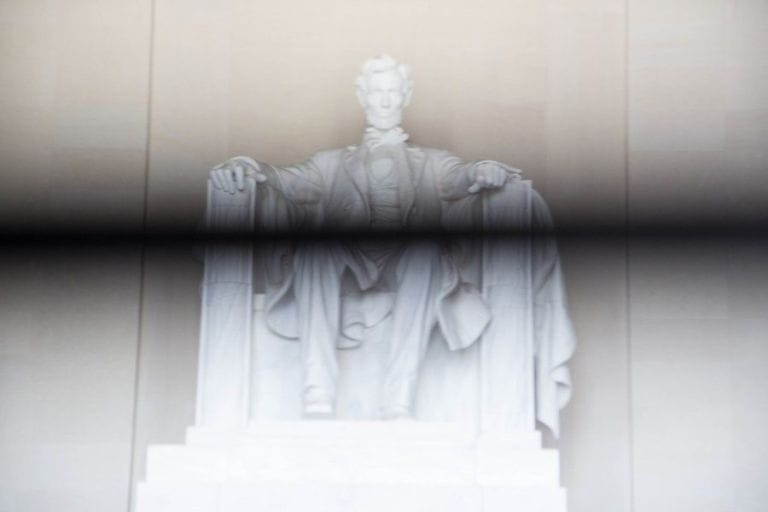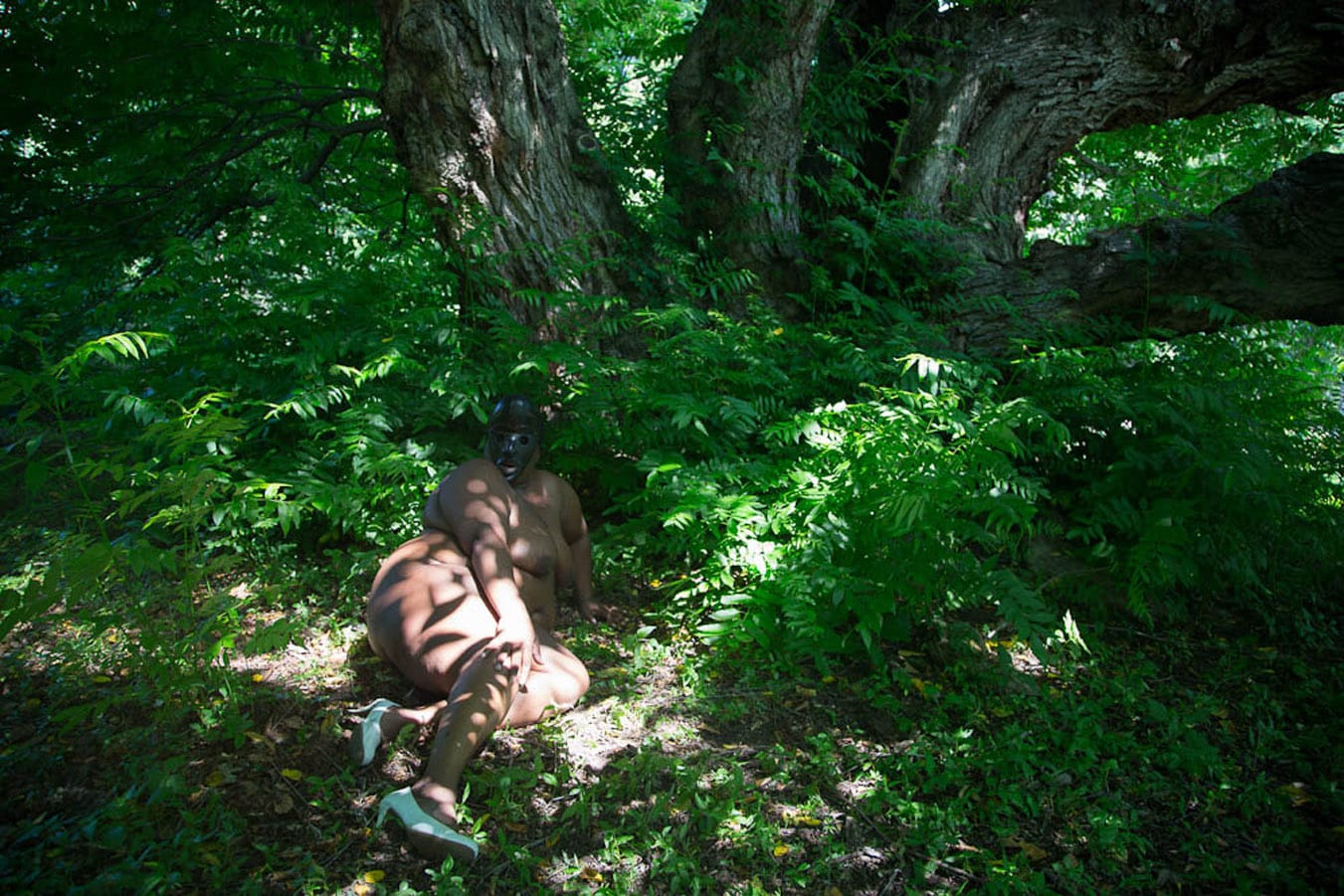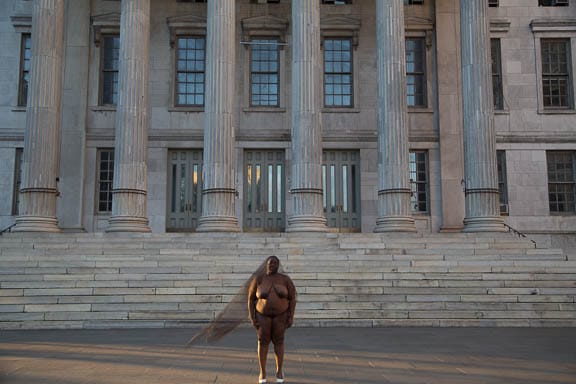Nona Faustine: Splicing Through Symbol

In and out of the photographs, Nona Faustine’s work is about living: Black life, Black nurture, and the restoration of self and legacy that motherhood bestows. Motherhood is not a universal experience. Of all obstacles to raising black and mixed race children in America, the inescapable jurisdiction that Black life was never meant to thrive here remains the most violent undercurrent against bodies of color. Motherhood, for women of color, carries in its flesh a celebration of control over body and lineage. Faustine makes no secret that her photographic work is an offering to the arrival of a baby girl in a Brooklyn house of women, a testament to survival.
Faustine first pulled public attention for the 2013 series “White Shoes,” in which Faustine’s nude body stood, and acted, defiantly upon historic sites of slavery throughout New York City. In person, Faustine will tell you the many misconceptions surrounding the city’s history of slavery, mainly the problematic narrative that slavery was mostly a southern system. Who does that perception serve at a time when the US is undergoing a “Civil War memorial boom
for the last twenty years”1?
In 1860 a prominent New York Senator, William H. Seward, proposed a document which became known as the Corwin Amendment after passing the Senate in 1861. President Abraham Lincoln supported it, and this is worth noting because Lincoln would later use the term ‘emancipation’ to mean what we now call deportation, or expulsion. Drafted in language designed to protect states’ rights, this precursor to the 13th Amendment was explicit:
"No amendment shall be made to the Constitution which will authorize or give to Congress power to abolish or interfere, within any State, with the domestic institutions thereof, including that of persons held to labor or service by the laws of said State."3
That this rarely discussed amendment remains legally dormant raises significant questions about citizen rights. In contrast is the magnificence of Black culture in America, a triumph really, because on this soil Black and mixed race people were obviously never expected to survive, as encapsulated into amendment by a New York Senator. By undermining the white washed history of the city’s development and exploitation, Faustine’s work points to longstanding political tensions defining American history. One work from this series, She Gave All She Could And Still They Ask For More, 2014, is one of two photographs by Faustine currently in The Museum of Sex’s "NSFW: The Female Gaze" exhibition.

In She Gave All She Could…., a voluptuous, golden body is shaded from crisp sunlight by layers of springtime foliage, face covered by a black tribal mask. The reclining odalisque references compositions found in paintings of ‘others,’ specifically 19th and 20th century depictions of female bodies sexualized through imperial values and a growing appropriation of cultural objects into Western themes. But Faustine’s photograph does not show us a passive body. The eyes behind the mask confront the viewer directly, as fingers point strategically to the white shoes—to the paths of whiteness upon which that body hastreaded.
Faustine’s work has emerged at the junction of our most pressing public conversations redefining American culture. In 2014, Faustine’s “White Shoes” gained momentum at a time when younger generations of pro-Black movements gathered in nation-wide protests against the on-going genocide and mass incarceration of black bodies. In early 2017 Faustine presented “My Country” at Baxter Street gallery, at a time when some cities and states began tacitly removing statues, flags, and other memorials to the confederacy after the Emanuel A.M.E. Church massacre in Charleston, South Carolina. Half way through 2017, the removal of a Robert E. Lee statue from a park in Charlottesville, Virginia prompted an insurgent white nationalist backlash. Faustine’s “My Country” series explores public monuments and the obstructions they represent in the form of historical and educational trauma.
“The Kodak does no more; it cannot preach sermons or solve
problems.”
—Anna Julia Cooper, A Voice From the South, 1892
Photography has played a significant role in the tense relationship between representation and historical accuracy. Although the most photographed American of the 19th Century was Frederick Douglass, other black abolitionists also had their portraits taken for political circulation and affirmation. Images today are deeply entrenched signifiers in our political understanding, a social power with limitations that public intellectual Anna Julia Cooper easily understood. As a feminist parent, Faustine is aware of the symbols that public monuments communicate, and how they fortify a superstructure of racialized state practices. The current reevaluation of confederate monuments cannot be separated from the paths such eulogized individuals paved for a “free white people everywhere.” Because white slave owners created the conditions for a so-called emancipation, Faustine’s photographs consistently point to the forced suspension of Black survival: between denied self-governance and forms of liberty that remain shaped by the volition of Whiteness.

What follows is an interview with Nona Faustine, began in summer of 2016 and completed in early 2017.
Patricia Silva: Your series My Country points to the public presence of obstacle in several ways. One, every image is obstructed and perceptually intervened upon. And then, you chose sites and monuments that have significance for the obstacles that Black folks have had in the U.S.
Nona Faustine: The first image of the Statue of Liberty brought me to this view point. I began to think about the ways in which democracy, truth and justice have been obstructed, obstacles put in place to freedom in this country, but also the ways in which a current of black history runs through these monuments, and through the principles and ideals of this country. When we look at this past election or President Obama’s eight years in office, is that not the greatest example of obstruction and obstacles? I was looking for a way to convey these ideas, thoughts and feelings through photography.
Patricia: My Country shows a different side of you and what you can do. I love what you said to me about these pictures, that they “splice through symbol.”
Nona: I wanted to add another layer to the story, one that defines these monuments and statues in a different way. I hope it makes people question and think of a new narrative. This city should be flooded with statues and monuments to the Lenape, Erie, Iroquois, Mahican, Mohegan, Montauk, Neutral, Oneida, Onondaga, Sapon, Seneca, Tuscarora, Tutel, Wappinger, Wenrohoron tribes that belong to this area. In thinking about that I realized that the colonizer does not ever if rarely makes celebratory symbols of the conquered, the colonizer’s job is to erase all evidence of the conquered and the crimes committed against them, to do so would indict themselves. There is always fragments of evidence left behind.
Patricia: The reference to native culture in My Country is unmissable.
Nona: They are the original people of this land, and have existed here longer than anyone. The injustice going on at Standing Rock Reservation and the protest brought all of that history to the forefront. War, genocide and environmental racism have been waged upon these people for four hundred years! In my research I often come across the stories and names of Native tribes and accounts from the early settlers of what the land looked like and Native peoples place in it. I have such reverence for them they deserve the highest praise.
Patricia: When we spoke of this series at your studio, you refered to My Country as being about American icons and monuments. That tension between monuments and history.
Nona: Monuments and icons are symbols which we judge societies by, they speak for the culture that produces them. They signify what that culture wants you to know is important to them. Those symbols are only half truths they can’t possibly tell the whole story but we invest an awful lot in them. We imbue them with such power, they’re guardians in many cases. In looking at the ones I choose how they stand in for these grand legacies that often are in conflict with the truth.
Washington statue at Federal Hall stands like a glorious God at Wall Street with Washington’s hand outstretched like Moses parting the Red sea. He was also a notorious slave master. His legacy is guarded protected and nurtured by corporate America, indicated by the American Express signs that hang over his statue from the building’s facade. Where are the statues to the slaves that built his fortunes that fought in the Revolutionary war with him? Why aren’t there statues and monuments to the slaves that built the Stock Exchange they were the first commodity? What about the countless other corporations many still in existence today that were built by the institution of slavery?
Patricia: When you began making White Shoes in 2012, the national dialogue about race was far more idealistic than what the mainstream discussions we’re having now. This dialogue continues to evolve. Has this made it easier or harder to discuss your work?
Nona: I think it has made it easier. People took to the work because so much of what I was saying they felt, the environment was being shaped. It was a few years after President Obama’s first term that folks began to understand there was no post racial, that things had not changed that drastically for people of color around race because we had a black President. I think it brought out this whole other conversation about healing and trauma in the face of ongoing oppression.
Patricia: When you photographed in Washington DC, and on the Staten Island ferry, what did it feel like to photograph this series without presenting your own body as a form of confrontation?
Nona: I felt it was necessary to make the shift and bring in a different element and experiment. It was just like how I use to shoot before I started White Shoes and all the times in between. I continue to do other projects without me being present in the work. For a large part of my life as a photographer other people have been the subject. It was through self-portraiture that my work became known. I had envisioned the current project long before I shot it, and was excited for the chance to show another side of my capabilities. I remember talking about it with a friend and being a little nervous about going to Washington by myself. My sister said, “What’s going to happen? Like, what are you afraid of…”
Patricia: 2017 has been incredible for you. You spoke at the Guggenheim, participated several notable shows—at the Studio Museum of Harlem, The Museum of Sex, Sprüth Magers in Los Angeles—but I was actually very delighted to see your first short film, Walking with Frederic, at the inaugural New York Feminist Film Week earlier this year. What made you think about retracing Frederick Douglass’ steps?
Nona: I came to the idea from my research on slavery in NYC when I came across a passage where Frederick Douglass himself says he was “standing at Lispenard and Church street” which placed him across the street from Abolitionist David Ruggles’ house. Douglass had just escaped to freedom from Maryland. I used still shots of me walking the route he would have taken to freedom.
Patricia: This film is the only work of yours in which we see your white shoes in motion, right? It has been such an intense political year, but so was 2016. Has the current political climate held any influence on how you have been shaping your photographs?
Nona: “Say Her Name” is one of those images. Yes, the current climate of my country has had a tremendous effect on me. The killings of black women and children specifically. If one hasn’t been affected by the changed terrain of the land and the actions of politicians who pass legislation and design laws that in effect plays with people’s very lives then they are either one of them and or part of the problem. The artist responds to what is going on around them, what we see, and the ways in which society is affected. Photography has been an incredible tool to help me do that.
Nona Faustine’s work is currently on view in the "Making Them Known" exhibition at Artspace in New Haven, CT, and in "NSFW: The Female Gaze exhibition" at the Musem of Sex, New York,
NY.
NOTES
(1) ‘There has been a Civil War memorial boom going on over the last 20 years,’ said W. Fitzhugh Brundage, the chairman of the history department at the University of North Carolina at Chapel Hill. At least 36 have gone up in North Carolina alone since 2000, he said, as many as were put up between 1940 and 1990. Of those, 20 are to Confederates and four are to Union forces.”
https://www.nytimes.com/2017/08/30/us/confederate-monuments.html
(2) In Clayborne Carson, Emma J. Lapsanksy-Werner, and Gary B. Nash’s The Struggle for Freedom: A History of African Americans, (Upper Saddle River, New Jersey: Prentice-Hall Inc, 2011), 242, the authors provide an account of Frederick Douglass leaving the White House shocked after a meeting with Lincoln, who urged him and others present to encourage Blacks to leave the United States.
(3) The Corwin Amendment protected institutional slavery by granting state regulation of “domestic institutions.” Second, it prevented Congress from having any power to “abolish or interfere” with “persons held to labor or service.” Third, it made itself unamendable. The Civil War interrupted the progression of the Corwin Agreement, but it remains actionable—why?
(4) Lerone Bennett’s Forced into Glory: Abraham Lincoln’s White Dream describes Lincoln’s “White Dream” as a place for “free white people everywhere,” and that the Emancipation Proclamation was released as a war measure, not as a step towards equality.